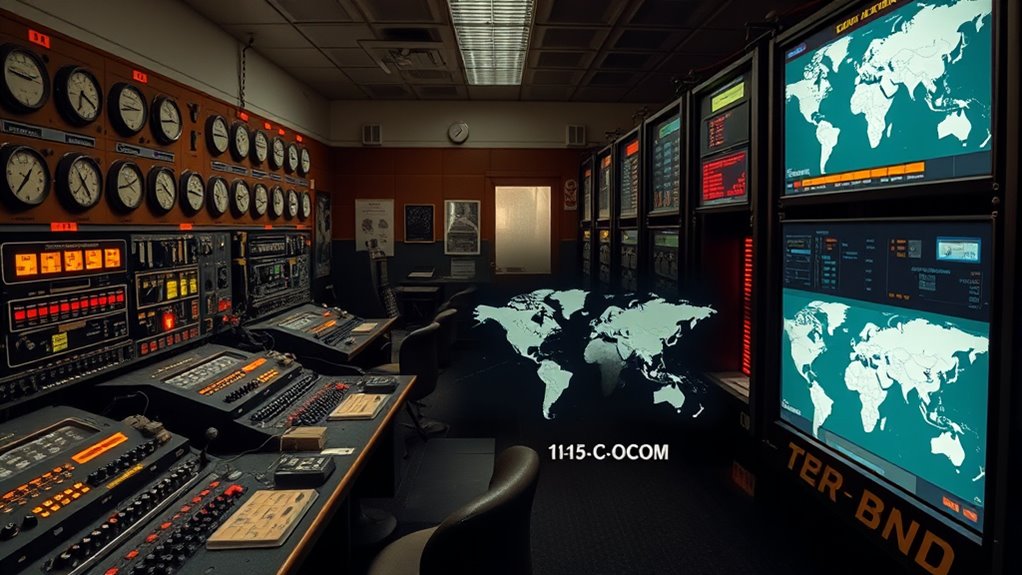Tech sanctions have evolved from Cold War-era controls like CoCom, which strictly limited sensitive exports to Communist countries, to today’s more sophisticated measures. Modern export bans target specific technologies and use advanced tools like AI and cyber monitoring for enforcement. These strategies balance national security with global innovation, often impacting markets and companies worldwide. If you keep exploring, you’ll discover how these changes shape today’s tech landscape and international relations.
Key Takeaways
- Cold War-era CoCom focused on strict export controls of sensitive military and dual-use tech to Communist countries.
- Modern sanctions have expanded to target cyber espionage, IP theft, and include financial and corporate blacklists.
- Today’s tools incorporate AI, cyber monitoring, and real-time enforcement to enhance precision and adaptability.
- Post-Soviet changes shifted sanctions from Cold War boundaries to broader economic and security objectives.
- International cooperation and multilateral frameworks are now central to evolving export bans and sanctions strategies.

Tech sanctions have long been a tool for governments to influence other nations, but their methods and impact have evolved considerably over time. In the early days, the history evolution of tech sanctions was largely shaped by Cold War politics, with initiatives like the Coordinating Committee for Multilateral Export Controls (CoCom) emerging as a central mechanism. CoCom was established in the 1950s to restrict the export of sensitive technology to Communist countries, aiming to contain their military and technological advancements. During this period, the policy impacts were straightforward: sanctions targeted specific countries or regimes, and the primary goal was to prevent access to advanced military tech. These controls were often rigid, with strict licensing requirements and all-encompassing lists of prohibited items, creating a clear boundary between allowed and banned exports.
As time progressed, the landscape of tech sanctions expanded beyond Cold War geopolitics. The fall of the Soviet Union and the rise of global interconnectedness shifted the focus towards economic stability and national security. Governments began adopting more nuanced policies, balancing the need to promote innovation domestically while restricting access to critical technology for adversaries. Today, the policy impacts are far more complex. Modern tech sanctions encompass a broad range of tools, from export bans to financial restrictions and blacklisting companies. These measures are often targeted and dynamic, adjusting in response to evolving threats like cyber espionage, intellectual property theft, and the proliferation of dual-use technologies. For example, current export bans on semiconductor technology aim to prevent countries like China from developing advanced military capabilities, but they also risk disrupting global supply chains and innovation ecosystems. Additionally, the integration of advanced enforcement tools such as AI and cyber monitoring has made sanctions enforcement more sophisticated and adaptable. This evolution demonstrates how sanctions now incorporate technological advancements to improve enforcement efficiency and precision. Furthermore, the ongoing development of international cooperation mechanisms reflects efforts to create more effective multilateral responses to emerging threats. These developments are essential for adapting to the rapid pace of technological change, which continuously reshapes the global security landscape.
You can see how the evolution of these policies reflects changing geopolitical realities and technological advancements. The early focus on broad, multilateral controls has shifted to targeted, often unilateral actions that leverage the power of financial systems and international cooperation. The policy impacts today are more layered, affecting not just the targeted nations but also global markets, multinational companies, and innovation networks. As technology continues to advance at a rapid pace, the methods of enforcing sanctions are becoming more sophisticated, utilizing tools like AI and cyber monitoring. Understanding this evolution helps you grasp how tech sanctions have transformed from straightforward embargoes during the Cold War into intricate, multi-layered strategies meant to shape global tech development and security in the modern era.
Frequently Asked Questions
How Have Tech Sanctions Impacted Global Innovation?
You might notice that tech sanctions have slowed down some technological innovation by restricting access to key technologies. However, they also encourage global collaboration among countries seeking alternative solutions. While these restrictions can hinder progress, they often push innovators to develop new, independent technologies. Ultimately, tech sanctions shape the landscape of innovation by balancing control with the need for international cooperation, influencing how countries and companies advance in a competitive global environment.
What Are the Legal Challenges of Enforcing Export Bans?
You might think enforcing export bans is easy, but it’s a nightmare of epic proportions. Jurisdictional conflicts and enforcement difficulties make it nearly impossible to track every illegal transaction. Governments struggle to coordinate across borders, risking loopholes that bad actors exploit. This chaos hampers efforts to prevent sensitive tech from reaching malicious hands, creating a web of legal challenges that complicate safeguarding national security and economic interests.
Which Countries Are Most Affected by Tech Sanctions?
You’ll find that countries like China, Russia, and North Korea are most affected by tech sanctions. These restrictions aim to curb cybersecurity threats and prevent access to advanced technology, but they often lead to supply chain disruptions. You might notice that these nations experience limited technological development and increased isolation, which impacts their economy and security strategies. Keeping an eye on these dynamics helps you understand the broader implications of global tech restrictions.
How Do Companies Navigate Compliance With Evolving Restrictions?
Imagine you’re a company exporting dual use technology; staying compliant means constantly monitoring export restrictions. You implement compliance strategies like regular training, real-time screening, and updating internal policies. For example, a firm might use automated software to flag restricted destinations. As restrictions evolve, you adapt by engaging legal experts and maintaining open communication with regulators. This proactive approach helps you navigate changing regulations and avoid penalties effectively.
What Are the Future Trends in Tech Export Controls?
You should watch future trends in tech export controls closely, especially around emerging technologies like AI and quantum computing. As nations develop new diplomatic strategies, expect stricter regulations and more sophisticated enforcement. Staying ahead means understanding how these controls evolve, so you can adapt your compliance efforts. By anticipating shifts, you’ll better navigate international markets and avoid penalties, ensuring your tech innovations align with global security priorities and diplomatic goals.
Conclusion
Remember, tech sanctions are like a double-edged sword—cutting both ways. They can stifle innovation yet expose vulnerabilities, much like a mirror reflecting shifting global power. As you watch these measures evolve from COCOM to today’s export bans, realize they’re not just policies but chapters in a larger story of competition and control. Stay aware, because in this game of technological chess, every move shapes the future you’re about to inherit.








